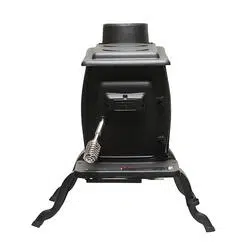Loading ...
Loading ...
Loading ...

-9-
ADDITIONAL REQUIREMENTS PERTAINING TO FIGURE 8 AND THE ABOVE WALL PASS-THROUGH SYSTEMS
1. Insulation material used as part of wall pass-through system shall be of noncombustible material and shall
have a thermal conductivity of 1.0 Btu • in./ft.² • °F (4.88 kg • cal/hr • m² • °C) or less
2. All clearances and thicknesses are minimums: larger clearances and thickness are acceptable.
3. A chimney thimble, as shown for 3" and 4" above (Parts C and D respectively of Figure 8) shall be for types "3"
and 4" connections to facilitate removal of the chimney connector for cleaning. The chimney thimble shall
be of ASTM C315 reclay with 5/8" minimum wall thickness, or material of equivalent durability. The inside
diameter of the thimble shall be sized for the proper snug t of a 6" diameter chimney connector pipe. The
thimble shall be installed without damage to the chimney ue. The thimble shall extend through the chimney
wall to, but not beyond, the inner surface of the chimney ue and shall be permanently cemented in place
with high temperature cement.
4. A chimney connector to a masonry chimney, except for 2" above (Part B of Figure 8), shall extend through
the wall pass-through system to the inner face of the chimney ue, but not beyond. It does not have to be
fastened in place so long as it cannot accidently be pulled out of the chimney or shoved into the chimney
ue. If fasteners are used to secure the chimney connector to a masonry chimney, the fasteners shall not
penetrate the chimney ue liner.
5. Any material used to close up any opening for the connector shall be noncombustible.
PART E
In addition to the methods shown by A, B, C, and D of Figure 8, a listed factory-built wall pass-through system may
be purchased and installed according to the instructions packaged with it to provide a safe method of passing
chimney connector through a combustible wall for a connection to a masonry chimney.
CONNECTION OF CHIMNEY CONNECTOR TO A MASONRY CHIMNEY WHEN CHIMNEY CONNECTOR DOES NOT
PASS THROUGH A COMBUSTIBLE WALL
If the chimney connector does not have to pass through a combustible wall to get to a masonry chimney, simply
connect the chimney connector directly to the masonry chimney's chimney thimble as described and shown by
parts C and D. Remember, the chimney connector should extend into the chimney thimble to the inner face of
the chimney ue but not beyond; if the chimney connector is extended through the chimney thimble into the
chimney ue, resistance to the ow of smoke and gases up the chimney will occur; that ow resistance will have
an adverse affect on the operation and performance of the heater and venting system.
CAUTION! NEVER USE GASOLINE, GASOLINE-TYPE LANTERN FUEL, KEROSENE, CHARCOAL LIGHTER FLUID, OR
SIMILAR LIQUIDS TO START OR "FRESHEN UP" A FIRE IN THE HEATER. KEEP ALL SUCH LIQUIDS WELL AWAY FROM THE
HEATER WHILE IT IS IN USE.
WARNING! NEVER STORE FLAMMABLE LIQUIDS, ESPECIALLY GASOLINE. IN THE VICINITY OF THE HEATER.
CAUTION! OVERFIRING THE APPLIANCE MAY CAUSE A HOUSE FIRE. IF A UNIT OR CHIMNEY CONNECTOR GLOWS,
YOU ARE OVERFIRING.
WARNING! NEVER OPERATE THIS HEATER WITH THE FUEL DOOR OPEN.
WARNING! USE ONLY THE LEGS PROVIDED WITH THIS HEATER. REFER TO THE "INSTALLATION" SECTION OF THIS
MANUAL.
CAUTION HOT WHILE IN OPERATION. KEEP CHILDREN, CLOTHING AND FURNITURE AWAY. CONTACT MAY CAUSE
SKIN BURNS
CAUTION DO NOT BURN GARBAGE OR FLAMMABLE FLUIDS SUCH AS GASOLINE, NAPHTHA OR ENGINE OIL
CAUTION! USE WOOD OR WOOD-LIKE MATERIALS ONLY. DO NOT USE COAL OR CHARCOAL. COAL OR
CHARCOAL WILL DESTROY THE FIREBOX. DO NOT USE DRIED LUMBER OR TREATED WOOD.
NOTE: DO NOT ELEVATE FIRE OR USE WITH A GRATE, BUILD FIRE DIRECTLY ON THE HEARTH.
WARNING! DO NOT OBSTRUCT THE SPACE BENEATH THE HEATER
Loading ...
Loading ...
Loading ...
